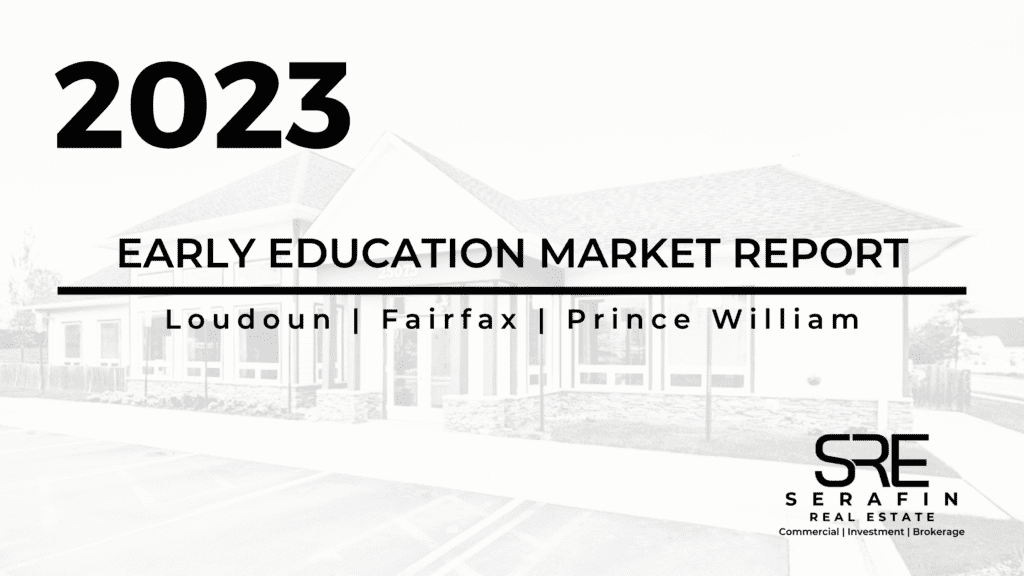Background Market Information and Trends in Early Education
We will start broad, by covering national numbers and then narrow everything down to the specific stats for early education CRE in Fairfax, Loudoun, and Prince William Counties.
The Purpose of this Article
It is essential for would-be investors to understand the overall early learning and childcare market. By providing this detail we want our clients to know they are making high-quality decisions. They may be owner-operators or passive investors; what matters is they understand enough about the market’s recent history, where it is now, and what the likely future trend will be.
They should know the forces that drive this market, the current situation, and the future trends. Our goal is to enable each of our clients to know that the decisions they make are in line with their overall objectives and are supported by known and expected market factors
A National Overview of Early Education
- The global market for early childhood learning Is expected to grow to almost $430 Billion by 2030, and to have a compound annual growth rate (CAGR) of 8.43%.
- The US child care market, in 2022, was valued at $60.4 Billion and is expected to see a CAGR of 4.18% during the same timeframe.
More parents are returning to work. There is, in addition, an increasing number of single parent families, plus families where both parents are going out to work. The demand for childcare and early learning centers is being driven both by a desire for parents to give their children the best start in life, and also by simple practical need. Learning technologies are advancing in the educational field as well as in center management and client communications.
While there is federal funding available, it is reducing, so state governments are, in many cases, filling the breach. Statistics show that, where possible, parents are prepared to pay higher fees, which is also fueling the increased demand. Parental contribution is a major issue, especially in areas such as Northern Virginia where income is, typically, above the national average.
Early Learning Industry Trends 2020 Through 2023
The childcare market is made up of infant care, day care and early learning, plus support and back-up services. In 2022, day care and early learning made up 47% of the total market. Current trends indicate:
- Funding: The American Rescue Plan will expire this year and Child Care and Development Block Grant (CCDBG) will expire in 2024, so local funding and parental fee increases can be expected.
Funding was used by different states in different ways. In some, the focus was on paying salaries, in others the focus was on improving infrastructure, and others focused on professional development. In addition, some states distributed ARP funds more quickly than others.
It is also worth considering that early learning programs in some states developed more quickly or more slowly than in others simply because of the general economic recovery and job growth. - Educational Changes: Many parents prefer a Montessori-based learning environment over traditional teaching environments. Many pre-school learning centers are introducing STEM (Science, Technology, Engineering, Math) into their curriculum. That is being counter-balanced, and supported, by social, emotional, and creative learning (SEL) methods.
The whole idea is to encourage young children to develop into well-rounded students who will, ultimately, enter the workforce of the future. - Hiring: There is still a shortfall in qualified early learning specialists, following COVID. Employment peaked at 1.05 million prior to the pandemic lockdown, then numbers fell to 680,000 in April 2020. By November 2022, numbers were back up to 92% of pre-pandemic levels (91% in Virginia as a whole, but only 84% in DC). The result is that early learning centers are typically offering higher salaries and improved job benefits to attract and retain high quality teachers and staff members.
Nationally, the average number of employees per provider was 14.2 in January 2020, but only 12.6 in June 2022.
Interestingly, Virginia has seen a 2.6% increase in programs being offered, and DC has seen an increase of 4.3%. - Technology: To improve management and monitoring of both learning processes and business operations, early learning centers are increasingly using technology to:
Maximize business ops.
Enable auto-billing and payment monitoring.
Track learning and test assessment for each student and for the class as a whole.
Offer easy access to a child’s progress by the parent or guardian.
Obvious results of increased technology are that fewer employees are needed to deliver management and communication services, so more emphasis can go to recruiting high caliber teachers and other child-facing professionals.
Northern Virginia Strategic Review
Serafin RE has continually kept our clients up to date with market reviews. We published an Early Education 5-Year Market Review where we focused on Fairfax, Loudoun, Prince William, Arlington, and Alexandria Counties with particular emphasis on $/SF paid, cap rates, and lease rates. In another Early Education Market Report, we discussed how early learning centers make an excellent investment.
A strong foundational argument is that well-educated parents with high salaries spend money on their children’s futures. We also provided statistics in that report on such things as average salaries and the market cap rates over a 10-year period. That way, potential investors gained a clearer understanding of what Northern Virginia’s early learning center market may offer.
Northern Virginia’s Economy and Early Learning Market
Early Learning
In 2021 the Virginia Chamber introduced its strategy to improve the state’s overall economic climate.
The overall goal is for Virginia to be the best in America for business, by focusing on 11 specific areas in its Blueprint Virginia 2030, the plan emphasizes seven strategies including:
- Encouraging policies and strategies that enable companies to support access to affordable and high-quality early learning.
- Expand public and private partnerships which encourage preschool services.
- Support strategies that make the child care industry stronger and more affordable to a wider population.
- Encourage and enable improved curriculum development.
- Introduce coaching programs for teachers to improve classroom learning and teaching methods from early learning through 3rd Grade.
The overall objective is for public and private sectors to work together to deliver on long term improved early education and child care facilities and services. One result should be that investment in early learning properties and other resources will be an integral and long-term part of the statewide strategy.
Northern Virginia Economy
Northern Virginia has seen consistent population growth. It did fall off during the pandemic, but between July 2020 and July 2021 four areas still continued to grow. Two of those included Loudoun and Prince William Counties. Overall growth returned in 2022, fueled by international migration and an increase in births over deaths.
Fairfax, Loudoun, and Prince William County CRE Statistics
If we drill down to specific numbers, we see that:
Fairfax County:
- Has 466 licensed childcare commercial centers.
- An average of 2.24% of childcare properties sell in any one year, equating to 11 childcare centers.
- 2015 saw the highest number of childcare centers sold. 29 sold which, together, exceeded $293 Million.
- Since 2012, the average Price per square foot has risen 45%.
Loudoun County:
- Has 172 licensed childcare commercial centers.
- On average, 5 (equaling 2.86% of the total) sell each year.
- 2014 saw the largest number of childcare centers sold with 29 changing hands, totaling $90 million.
- Since 2012, the average price per square foot has risen 179%.
Prince William County
- Has 148 licensed childcare commercial centers.
- On average, 4 centers sell per year, totaling 2.76% of the total.
- Since 2012, the average price per square foot has increased by 81%.
- The most properties sold was in 2013, when 29 centers sold at a total price of $40 million.
Serafin Real Estate
Serafin Real Estate (SRE) specializes in early learning centers and the child care market. Clients specifically work with SRE to buy or sell early learning and childcare centers. We have advised our clients and managed purchases and sales worth more than $80 million in just the last three years.
We have achieved an average sales price 56% higher than the local market average of sold early education centers.
To learn more about the childcare and early learning market in Fairfax, Loudoun, and Prince William Counties, please click here to contact us. Leave your basic contact details, select the reason from the listed options, and we will get right back to you.
* Data researched and collected via Costar (www.costar.com) and internal information of Serafin Real Estate.

